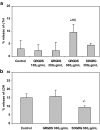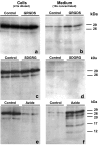Release of cardiac troponin I from viable cardiomyocytes is mediated by integrin stimulation
- PMID: 17909848
- PMCID: PMC2226063
- DOI: 10.1007/s00424-007-0354-8
Release of cardiac troponin I from viable cardiomyocytes is mediated by integrin stimulation
Abstract
Elevated cardiac troponin-I (cTnI) levels have been demonstrated in serum of patients without acute coronary syndromes, potentially via a stretch-related process. We hypothesize that this cTnI release from viable cardiomyocytes is mediated by stimulation of stretch-responsive integrins. Cultured cardiomyocytes were treated with (1) Gly-Arg-Gly-Asp-Ser (GRGDS, n = 22) to stimulate integrins, (2) Ser-Asp-Gly-Arg-Gly (SDGRG, n = 8) that does not stimulate integrins, or (3) phosphate-buffered saline (control, n = 38). Cells and media were analyzed for intact cTnI, cTnI degradation products, and matrix metalloproteinase (MMP)-2. Cell viability was examined by assay of lactate dehydrogenase (LDH) activity and by nuclear staining with propidium iodide. GRGDS-induced integrin stimulation caused increased release of intact cTnI (9.6 +/- 3.0%) as compared to SDGRG-treated cardiomyocytes (4.5 +/- 0.8%, p < 0.001) and control (3.0 +/- 3.4%, p < 0.001). LDH release from GRGDS-treated cardiomyocytes (15.9 +/- 3.8%) equalled that from controls (15.2 +/- 2.3%, p = n.s.), indicating that the GRGDS-induced release of cTnI is not due to cell necrosis. This result was confirmed by nuclear staining with propidium iodide. Integrin stimulation increased the intracellular and extracellular MMP2 activity as compared to controls (both p < 0.05). However, despite the ability of active MMP2 to degrade cTnI in vitro, integrin stimulation in cardiomyocytes was not associated with cTnI degradation. The present study demonstrates that intact cTnI can be released from viable cardiomyocytes by stimulation of stretch-responsive integrins.
Figures




References
-
- {'text': '', 'ref_index': 1, 'ids': [{'type': 'PubMed', 'value': '9732976', 'is_inner': True, 'url': 'https://pubmed.ncbi.nlm.nih.gov/9732976/'}]}
- Bleier J, Vorderwinkler KP, Falkensammer J, Mair P, Dapunt O, Puschendorf B, Mair J (1998) Different intracellular compartmentations of cardiac troponins and myosin heavy chains: a causal connection to their different early release after myocardial damage. Clin Chem 44:1912–1918 - PubMed
-
- {'text': '', 'ref_index': 1, 'ids': [{'type': 'PubMed', 'value': '10456204', 'is_inner': True, 'url': 'https://pubmed.ncbi.nlm.nih.gov/10456204/'}]}
- Chen YN, Wei JR, Zeng LJ, Wu MY (1999) Monitoring of cardiac troponin I in patients with acute heart failure. Ann Clin Biochem 36:433–437 - PubMed
-
- {'text': '', 'ref_index': 1, 'ids': [{'type': 'PubMed', 'value': '7538917', 'is_inner': True, 'url': 'https://pubmed.ncbi.nlm.nih.gov/7538917/'}]}
- Clarke MS, Caldwell RW, Chiao H, Miyake K, McNeil PL (1995) Contraction-induced cell wounding and release of fibroblast growth factor in heart. Circ Res 76:927–934 - PubMed
-
- {'text': '', 'ref_index': 1, 'ids': [{'type': 'PubMed', 'value': '10444506', 'is_inner': True, 'url': 'https://pubmed.ncbi.nlm.nih.gov/10444506/'}]}
- Coker ML, Doscher MA, Thomas CV, Galis ZS, Spinale FG (1999) Matrix metalloproteinase synthesis and expression in isolated LV myocyte preparations. Am J Physiol 277:H777–H787 - PubMed
-
- {'text': '', 'ref_index': 1, 'ids': [{'type': 'DOI', 'value': '10.1161/01.CIR.0000109483.45211.8F', 'is_inner': False, 'url': 'https://doi.org/10.1161/01.cir.0000109483.45211.8f'}, {'type': 'PubMed', 'value': '14691043', 'is_inner': True, 'url': 'https://pubmed.ncbi.nlm.nih.gov/14691043/'}]}
- Diris JH, Hackeng CM, Kooman JP, Pinto YM, Hermens WT, Dieijen-Visser MP (2004) Impaired renal clearance explains elevated troponin T fragments in hemodialysis patients. Circulation 109:23–25 - PubMed
Publication types
MeSH terms
Substances
LinkOut - more resources
Full Text Sources
Research Materials
Miscellaneous

